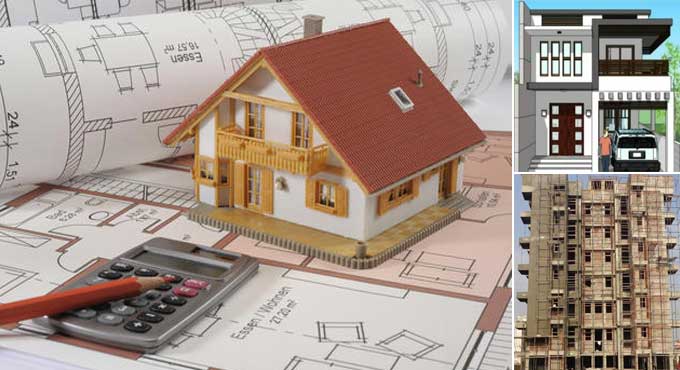
How to Estimate Buildings & their Methods of Construction
Buildings are estimated in different ways according to their nature. Whenever a project is initiated, an estimate is made about its fruitfulness and the cost involved. There are different ways in which rough cost estimation is conducted. The Detailed Cost Estimate method is also well-known for building estimation. The items of the building are determined, and their unit of measurement is multiplied by the unit of rate to calculate the cost.
A Detailed Estimate includes all types of costs. This method is therefore considered more accurate. Detailed Estimates are conducted to secure the approval of Technical Sanctions for the related project.
Methods of Building Estimation
Center Line Method
Centerline estimation is based on using up-to-center measurements of the wall. It is common to measure internally. For determining the Center Line of rooms, a half wall thickness from one side is added to a half wall thickness from the other side in internal measurements.
A wall whose cross-section is symmetrical will have a uniform Center Line length across its whole length if the steps are symmetrical. That would mean that the length of each step would determine separately if the steps are not symmetrical.
Short & Long Wall Method
The term "long wall" is defined as a wall running along the length of a room, while "short wall" refers to a wall parallel to the length. Find the centerline lengths of the long or short wall to get the wall's length. After adding half of the wall's length at each end, its centerline length may determine.
Approximately half the centerline length of the short wall can be subtracted from the measured length to calculate its length. From the earthwork to brickwork, the length of the short wall usually increases, while the length of long walls usually decreases.
Depth and breadth multiply by length to determine quantities.
Crossing Method
When the thickness of the external walls is equal in the building as a whole, and the thickness of the internal walls is also equal, but they vary in thickness.
In this case, this method is used for estimation.
Internal walls should be measured using the long wall & short wall method, and external walls should be measured using the centerline method.
Technical Terms in Estimation of Building
Plinth Area
An area overlaid with a plinth is called a plinth area. Also included are the verandas and other passages that have roofs over them. The plinth Area is measured from the outside edge of the wall to the inner edge of the wall.
Floor Area
The internal area of every room is called the floor area. Aside from the kitchen, the stair room, and the bathroom, there are three other rooms. An area enclosed by walls is not included in this definition.
Carpet Area
Residential rooms are included in the carpet area. Kitchen, bathroom, and stairways are not included in the measurements.
Market Rate
The rate assigned to each item in the market is the market rate. Taxes imposed on items include conveyance, wastage, and conveyance.
Schedule of Rates
The Engineering Department prepares schedules of rates for payments based on market rates. Cement rates, sand rates, gravel rates, steel rates include as well as labor and material rates. A labor rate is a rate of wages. A composite rate for labor and materials refers to a composite rate or CSR for short.
Rate schedules are regularly issued as a result of changes in market rates. The document is considered practicable for a minimum of three months at the start of each year. MRS stands for the Market Rates Schedule and is a file uploaded to the Internet.
Premium
The Schedule of Rates is subject to change even after it is issued, so additional rates are negotiated with the contractor. It is called Premium.
Bill of Quantity
Quantity Bills are statements of the items to be performed. Items names and the description of work will appear in this statement. There are, however, blank cells where the contractor has submitted the B.O.Q. for related rates and amounts. Once the rates and amounts have been entered, this statement will know as the Abstract of Cost.
Capital Cost
Capital Costs are the costs paid out throughout the project. Construction costs include, for instance, surveying, designing, supervising, water supply, sanitary, electric, gasification, and plot prices.
Prime Cost
The owner, the project manager, or the site engineer approves estimates by estimating the amounts that will be spent over certain things. A few examples include paying for door and window fittings, water supply, sanitary fittings, and electric fittings, among others. Prime Cost represents this amount.
Provisional Sum
Estimates are prepared with an amount reserved for items that are not determined. For example, the cost of installing telephone services, gas lines, internet, air conditioners, or elevators is known as a Provisional Sum.
Trees & Plants Charges
During the estimation process, T represents between one and one and a half percent of the total cost as well as P. Fees. Tools and plants are represented by T. and P. respectively.
Work Change Establishment
Workers are hired on a temporary basis during construction of the project, referred to as Work Charge Establishments. Members of this staff include secretaries, mates, and security guards, among others. Short-term enlistments are common. Paying their salaries or wedges accounts for between 1.5 and 2% of the overall cost.
Wrapping it Up
A building's estimated quantity and costs are calculated before the building is built, a skill called estimation. Building estimates can be divided into two categories based on their level of detail. It will not give you the exact cost, but it can give you an idea of how much the building will cost which will help you manage money for the building sufficiently.
To get more details, watch the following video tutorial.
Video Source: parag pal


